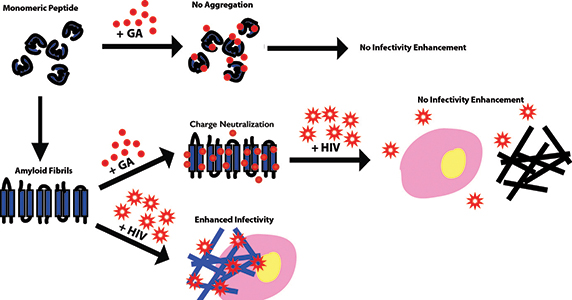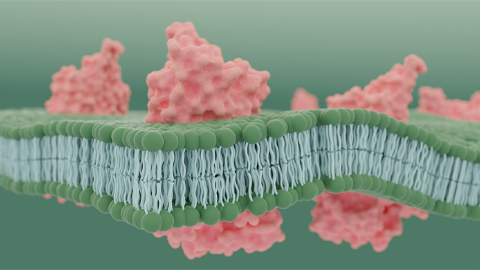JBC: Targeting semen amyloid fibrils to reduce HIV infectivity
The human immunodeficiency virus, which attacks the immune system, affects more than 1.2 million people in the U.S. There aren’t any vaccines or cures. Instead, microbicides are used to help protect against the transmission of HIV from person to person. However, the process of transmission isn’t understood fully and can involve both viral and human factors that promote infection.
 Gallic acid, or GA, coats the surfaces of amyloid fibrils in semen to prevent HIV infectivity enhancement and coats the peptide precursors to prevent fibril formation.IMAGE COURTESY OF JOSIE LORICCO
Gallic acid, or GA, coats the surfaces of amyloid fibrils in semen to prevent HIV infectivity enhancement and coats the peptide precursors to prevent fibril formation.IMAGE COURTESY OF JOSIE LORICCO
In a recent paper published in the Journal of Biological Chemistry, Nadia Roan of the University of California, San Francisco, and George Makhatadze of Rensselaer Polytechnic Institute described a small molecule that prevents a specific human factor from increasing the ability of HIV to cause infection.
Researchers know that the virus itself has many factors that help it infect new hosts. There are also human factors that play a role in the transmission of HIV and a person’s susceptibility to infection. One of these factors is the ordered accumulations of misfolded proteins called amyloid fibrils. These fibrils occur naturally in human semen and have been shown to increase HIV infectivity and decrease the effectiveness of anti-HIV microbicide treatments.
The infection-promoting fibrils have been observed in the semen of both healthy and HIV-infected men. Therefore, researchers want to identify compounds that disrupt the formation of these fibrils or rid them of their infectivity-enhancing properties and reduce the sexual transmission of the virus through semen.
The investigators, led by graduate student Josie LoRicco of Rensselaer Polytechnic Institute, used a screen of small molecules to identify compounds that altered the properties of specific amyloid fibrils in semen. One molecule that came out of the screen, gallic acid, further proved to be capable of reducing HIV infectivity in the presence of semen. “Gallic acid is a small molecule found naturally in many foods, including grapes and tea,” says Makhatadze.
LoRicco, Roan, Makhatadze and colleagues further investigated gallic acid’s properties. They used atomic force and confocal microscopies in addition to several quantitative assays to characterize the interaction between gallic acid and the fibrils. Surprisingly, gallic acid did not induce disassembly of the fibrils but instead bound to their surfaces.
The investigators conducted biophysical analysis of fibrils’ surface properties to understand the nature of the interaction. They demonstrated that gallic acid limits the ability of semen fibrils to enhance HIV infection by binding to the fibrils’ surfaces and neutralizing their surface charge. Additionally, the gallic acid-coated fibrils prevent the formation of new amyloid fibrils by binding the precursor components and changing their charge characteristics.
“Gallic acid appears to do two things,” explains Makhatadze. “First, it inhibits new fibril formation. Second, it interacts with pre-existing fibrils and renders them incapable of facilitating HIV infectivity.”
The investigators suggest that gallic acid may be a useful addition to multicomponent microbicides that target both viral and human factors involved in the promotion of HIV transmission and infection. Makhatadze suggests that “such combination microbicides will be more effective at preventing transmission compared to single-component microbicides.”
Enjoy reading ASBMB Today?
Become a member to receive the print edition monthly and the digital edition weekly.
Learn moreGet the latest from ASBMB Today
Enter your email address, and we’ll send you a weekly email with recent articles, interviews and more.
Latest in Science
Science highlights or most popular articles

Raw milk is risky, but airborne transmission of H5N1 from cow’s milk is inefficient in mammals
Findings suggest that cow’s milk infected with bird flu poses a real risk to humans, but the virus may not spread very far or quickly to others.

From the Journals: MCP
A deep learning approach to phosphoproteomics. Untangling complex proteomics mass spec data. Read about these recent papers.

Cholesterol synthesis and cancer
Researchers find that the active form of a key cholesterol synthesis enzyme is upregulated in endometrial cancer tissues.

This protein does “The Twist”
The NMDAR is involved in numerous cognitive functions including memory, and its movements are tightly coordinated like a choreographed dance routine.

The phageome: A hidden kingdom within your gut
Human innards are teeming with viruses that infect bacteria. What are they up to?

From the journals: JLR
Muscle lipids and metabolic syndrome. A new method for detecting peroxisomal disorders. Testing oligonucleotide therapy in NASH. Read about recent papers on these topics

